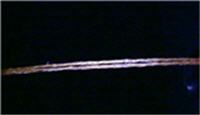 The tether experiment currently being run by Tethers Unlimited is off to a good start. For those of you unfamiliar with the experiment, three picosatellites have been launched for the purpose of deploying a HoyTether and monitoring it’s “health” while in space’s hostile environment.
The tether experiment currently being run by Tethers Unlimited is off to a good start. For those of you unfamiliar with the experiment, three picosatellites have been launched for the purpose of deploying a HoyTether and monitoring it’s “health” while in space’s hostile environment.
 The base picosatellite (“Gadget”) has been successfully contacted via radio. The deployment picosatellite (“Ted” – hey, what a great name! 🙂 ) has, so far, not made successful radio contact with ground control. However, the third picosatellite (“Ralph”), the one which will be traveling along the tether, photographing and monitoring its health, has sent back a preliminary picture of a portion of the tether – prior to deployment.
The base picosatellite (“Gadget”) has been successfully contacted via radio. The deployment picosatellite (“Ted” – hey, what a great name! 🙂 ) has, so far, not made successful radio contact with ground control. However, the third picosatellite (“Ralph”), the one which will be traveling along the tether, photographing and monitoring its health, has sent back a preliminary picture of a portion of the tether – prior to deployment.
Though this tether is certainly not a Space Elevator, the relevance of this experiment towards the eventual deployment of a Space Elevator is obvious; How will this tether survive in space? How successful will the robots be in deploying it? How successful will the robot be in traveling along, monitoring and photographing the tether? If this monitoring robot had repair capabilities (on the drawing board for the next experiment, I’m sure), then it would be even more relevant.
Check out the MAST blog to keep up-to-date with the rapid pace of events of this experiment. I can’t wait to see (and perhaps take) a picture of the fully deployed tether.

I’m looking forward myself to the results of this experiment.
This project certainly has the potential at reducing space flight costs, but flinging the craft outward which means that rockets can save their fuel for other items.
It’s not a space elevator, but its the next best thing.